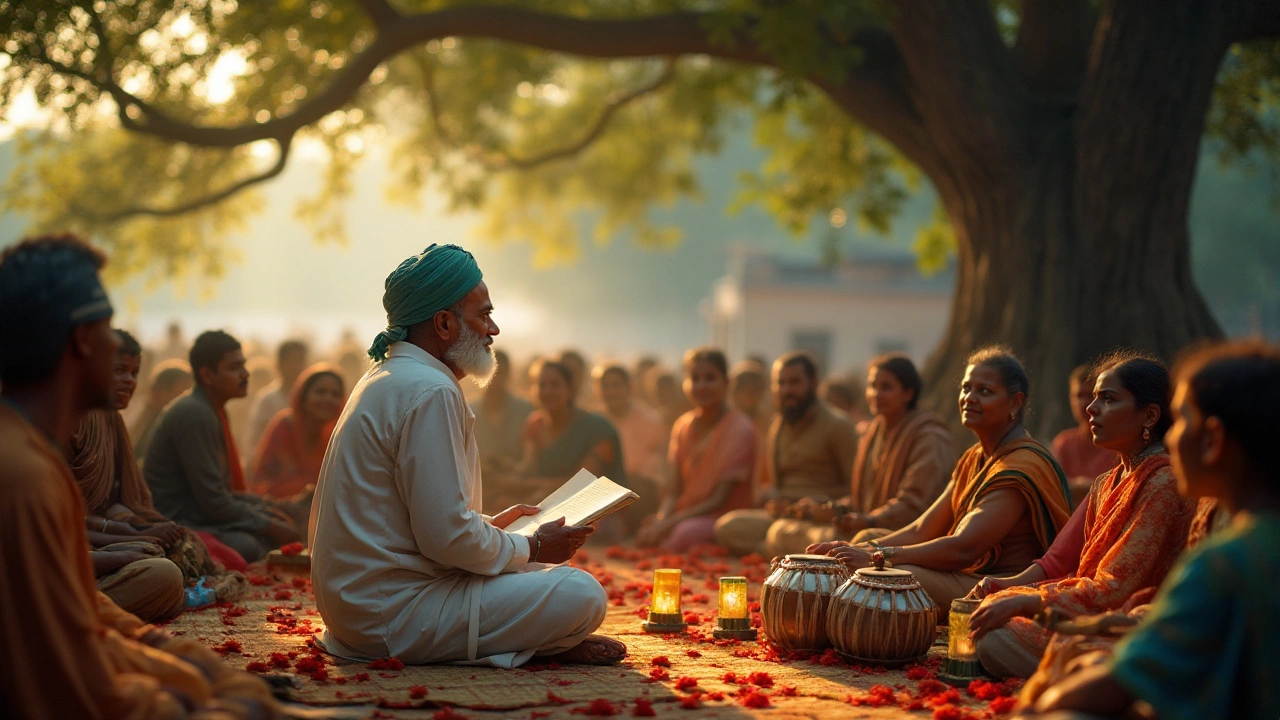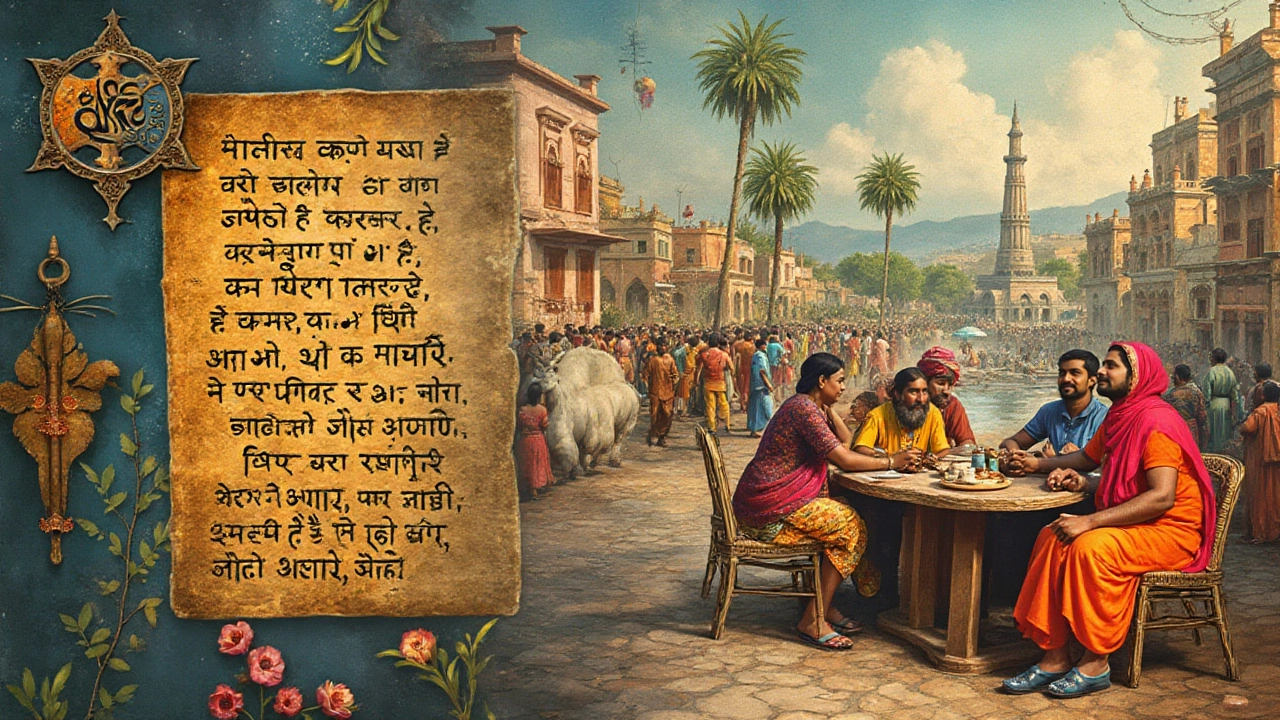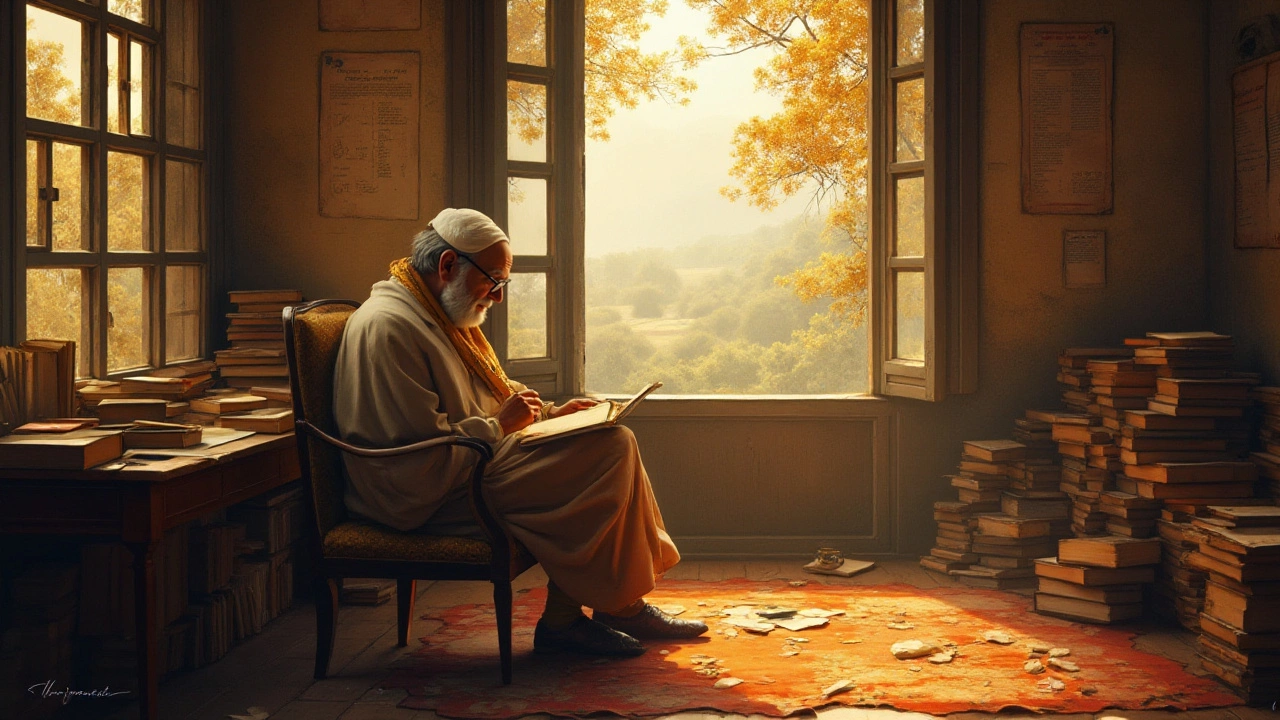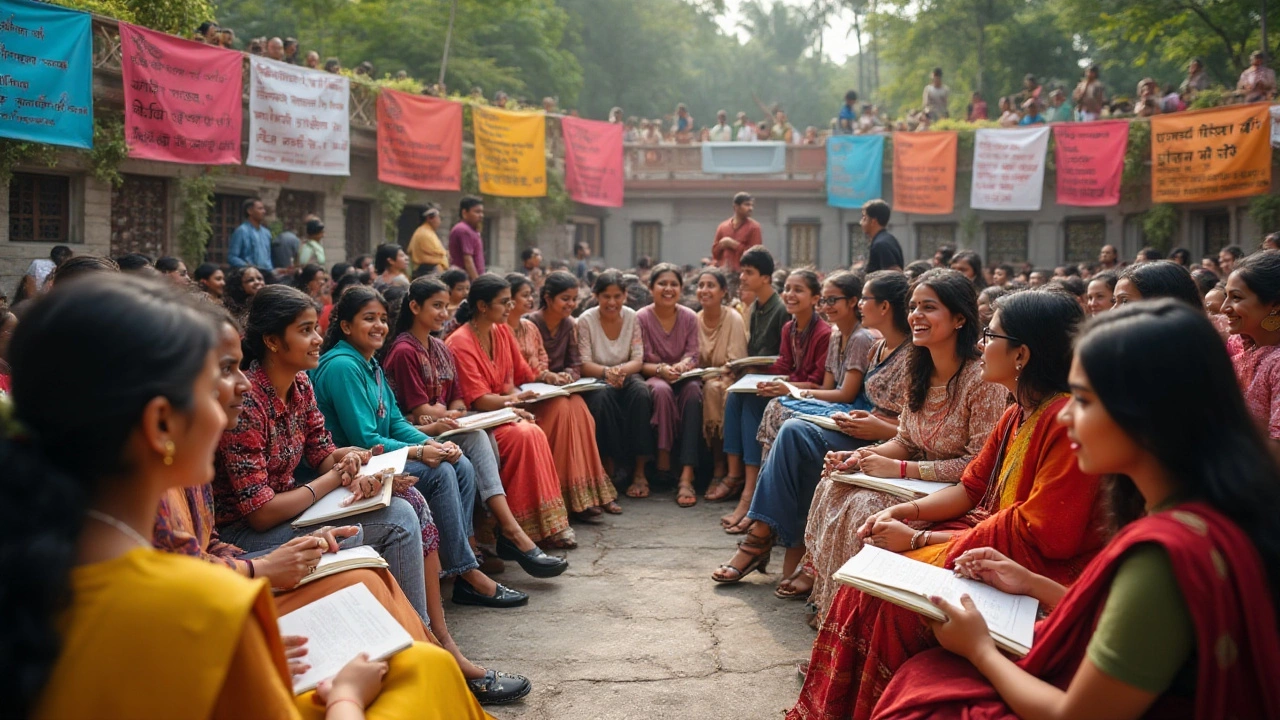Understanding Hindi Poetry: Essence and Expression

Hindi poetry holds a special place in the world of literature, rich in emotion and cultural depth. Known as 'Kavita', this form of literary art has been a medium through which poets express profound feelings and social commentary.
Tracing its lineage back to ancient texts, Hindi poetry showcases a diverse range of styles. From the intricate couplets of the medieval period to the free-verse of modern times, Hindi poems have evolved alongside the country's vibrant history.
Influential poets like Kabir and Tulsidas paved the way with verses that continue to resonate with people today. They capture not only the beauty and struggles of their times but also universal truths that remain relevant.
For those interested in delving into this world, understanding the subtleties and reading widely across different types could be an enriching journey. It's a treasure trove waiting to be explored, inviting readers to experience the heart of India through its poetic lens.
The Essence of Hindi Poetry
Hindi poetry, or Hindi Kavita, is a vibrant and soulful reflection of the cultural tapestry of India. Its essence lies in its ability to fuse emotion with the rhythm of language in unique ways. Spanning an era from Vedic poems chanted in reverence to deities, to the medieval Bhakti movement where poetry was a vehicle of devotion, Hindi poetry is as diverse as its cultural origins.
In Hindi poetry, emotion manifests through various forms, transcending the barriers of time and language. The common person finds a voice in poems in Hindi that speak of love, valor, nature, and spirituality. The Bhakti poets like Tulsidas and Meera Bai crafted verses that resonated with divine love. They often used simple language, making their works accessible to the masses and weaving spirituality into daily life.
Many great poets also emphasized social reform through their poetry. Kabir, a 15th-century poet, challenged orthodox practices and promoted equality. His couplets, known as 'Dohas', still influence modern literature and thought processes. His ability to articulate complex truths using a simple language style makes his works timeless. The quote "Wherever you are is the entry point" rings true across ages, encouraging readers to find poetry in their own life experiences.
"Wherever you are is the entry point." - Kabir
During the colonial period, Hindi poetry took on a nationalistic flavor, stirring the emotions of millions with its tales of freedom and resistance. The Progressive Writers’ Movement of the 1930s was propelled by poets such as Harivansh Rai Bachchan and his works like 'Madhushala' became an anthem of change and encouragement. 'Madhushala' does more than drown the mind in the allure of wine but dances through themes of existentialism and philosophical musings.
The modern era sees Indian poetry exploring individual experiences, urban life, and global issues, while still deeply rooted in traditional motifs. Contemporary poets experiment with free verse and unconventional forms, reflecting the dynamic nature of society. As forms transformed, the heart remained, binding these works under a humanistic approach focused on connection and empathy.
Hindi poetry today captures the zeitgeist and fuels the soul. It's a critical aspect of India's literary landscape—held dear by millions and constantly evolving with the times. For the uninitiated, it's a treasure trove of beauty that's sure to offer insights and an emotional connection to its readers.

Types of Hindi Poems
The world of Hindi poetry is as diverse as it is profound, offering a multitude of forms that cater to different tastes and preferences. At its core, many types of Hindi poems have evolved from traditional forms, each holding its own space in the literary canvas. One of the most ancient and revered forms is the 'Doha', a style that has been pivotal in crafting the identity of Hindi literature. Dohas are couplets, often imbued with moral or philosophical teachings, made famous by poets such as Kabir and Rahim. These verses, though brief, pack a depth of wisdom that continues to inspire readers across generations.
Another significant style is the 'Chaupai', typically used extensively in epic poems and also in compositions associated with devotional literature. The famous work 'Ramcharitmanas' by Tulsidas primarily employs Chaupai, showcasing a rhythmic and narrative style that appeals to those interested in storytelling through poetry. This format allows for a deeper exploration of themes, blending lyrical beauty with storytelling prowess.
Free verse or 'Muktak' is another style that gained prominence, especially during and after the independence movement. This form opposed rigid structures, allowing poets freedom to express personal and social musings in a more unrestricted manner. Poets like Harivansh Rai Bachchan used free verse to create evocative imagery and express sentiments of nationalism and personal introspection. Bachchan's 'Madhushala' remains a notable work in this category, bringing forth a shift in poetic expression that resonated with a changing world.
"Kavi ka sapna samay ke chaak par sab chhod dena
Jaho sab katake, kuch na ho kar pachhtata na ho." — Harivansh Rai Bachchan
Lyrical poetry or 'Geet' captures emotions beautifully, often accompanied by music. These poems emphasize rhythm and melody, making them ideal for songs and chants, echoing through marriage ceremonies and festivals. Works of Surdas fall into this category, infused with bhakti and rich in emotional texture. 'Geet' often finds use in popular media, where its sweet cadence and emotive language captivate audiences.
Narrative poems, often encompassed within ballads or 'Khandkavya', weave intricate stories through verse, painting vivid pictures of cultural and social events. These provide a platform for lengthy epics and tales, often forming the backbone of oral traditions. They bring to the reader tales of heroism, romance, and cultural heritage, allowing for a narrative that is both engaging and educational. Fortunately, each of these styles of Hindi poems, from the disciplined couplets of the Dohas to the liberating verses of Muktak, carries with it the essence of the time it represents, offering a unique glimpse into the hearts and minds of its creators.

Famous Hindi Poets
When we explore the realm of Hindi poetry, several legendary poets cast a long shadow with their extraordinary contributions. These poets not only influenced the literary world but also left an indelible mark on Indian culture and society. Their works serve as timeless reflections of human emotions, aspirations, and socio-political contexts. Let us delve into the lives and legacies of some of these luminaries, each offering a unique voice and perspective to the tapestry of Hindi literature.
Kabir, a 15th-century mystic poet and saint, is one of the most revered figures in the pantheon of Hindi poets. Known for his simple yet profound couplets, known as 'dohas', his work transcended religion and caste, promoting a message of unity, love, and devotion. Kabir's poetry is characterized by its universal appeal, blending concepts of the divine and motifs from everyday life with unparalleled elegance. His words continue to inspire and provoke thought across generations. 'Kabir says, listen with care, not the leaf but the soul ripples in the air'.
Another towering figure in the world of Hindi literature is Tulsidas, celebrated for his epic poem 'Ramcharitmanas', a retelling of the Ramayana in the Hindi language. Composed in the 16th century, Tulsidas's rendition made the tale accessible to the common man, bridging linguistic and cultural divides. His work goes beyond storytelling, offering philosophical insights and moral teachings that resonate deeply within the hearts of readers. Tulsidas's contributions are not merely literary endeavours but are entwined within the sacred and cultural fabric of India.
The modern age of Hindi poetry would be incomplete without acknowledging the contributions of poets like Jaishankar Prasad and Mahadevi Varma, who brought fresh perspectives to classic poetic traditions. Prasad, a key figure in the Chhayavad movement, is known for his exploration of themes such as nationalism, humanism, and spiritualism, often weaving them with rich imagery and symbolism.
Mahadevi Varma, hailed as the modern Meera, was a pioneering figure in bringing a feminist perspective to Hindi poetry. Her work often centered on the struggles and strengths of women, gaining her widespread acclaim and recognition. Whether it was touching on the intimate emotions of love and longing or the broader context of societal norms, Mahadevi’s poems resonated profoundly with her audience, instigating introspection and change.
The impact of these poets is best understood by examining their enduring influence on both literary circles and popular culture, where their words continue to be revered and celebrated. Their poetry bridges historical, cultural, and emotional divides, reminding us that art can serve as a powerful conduit for truth and transformation. Delving into their stories not only enriches our understanding of Indian poetry but also offers us new lenses through which to view the world.

Tips to Understand Hindi Poetry
Understanding Hindi poetry can be a rewarding endeavor, immersing you in India's rich cultural and emotional tapestry. Whether you're a beginner or an aficionado, these tips will enhance your appreciation and comprehension of this beautiful art form. Start by familiarizing yourself with the context in which the poem was written. Many Hindi poems emerge from periods of significant social and political change, and the historical backdrop can deeply influence the language and themes. Poets like Rabindranath Tagore and Mirabai, famous in India and beyond, wrote during times when their convictions and reflections were shaped by society's demands.
Another helpful approach is to learn some basic Hindi, if you're not a native speaker. While translations can offer insight, the original language conveys nuances and rhythmic qualities unique to poems in Hindi. Recognizing common literary devices used in Hindi poetry, such as metaphors, similes, and allegory, can deepen your understanding. For instance, the traditional 'bhakti' or devotional poems often utilize divine and natural imagery to express spiritual longing.
Engage with Local Communities
Engaging with local or digital communities that celebrate Hindi poetry can also be enriching. Many are happy to share interpretations and historical insights that bring a poem to life. You might even participate in poetry readings or discussions, which can offer new perspectives and foster a deeper connection to the material. The camaraderie found in these settings is invaluable and can lead to discovering poems and poets you might not encounter otherwise.Explore Modern Translations
Exploring modern translations and interpretations is key as well. They can shed light on complex themes and offer an accessible entry point into a poem’s world. A famous quote by the poet Gulzar encapsulates the essence of poems:"Poetry is when an emotion has found its thought and the thought has found words."Delving into such commentaries can guide your interpretation and appreciation of the layers within a work.
Lastly, maintaining a personal reflection journal where you note interpretations, feelings invoked, and questions raised can provide a dynamic and personal connection to the works. Hindi literature is as much about a personal journey as it is about historical and artistic appreciation. Through exploration and active engagement, the world of Hindi poetry opens up in a vivid tapestry of emotion and history.